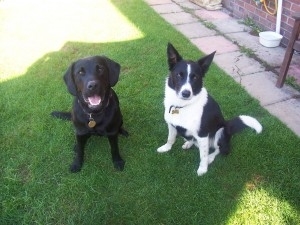Treatment for Vomiting & Diarrhoea

Dependant on age (so long as NOT a very small puppy), starve for 24 hours, offer a light meal of chicken or fish with Scrambled egg. Only give a small quantity. Then offer another small meal 6 hours later (chicken/rice) If your dog has further diarrhoea or vomiting then starve again for 24 hours. Any bouts of sickness should only last 24 – 48 hours anything longer than this should be checked by the vet. Make a note of how many times diarrhoea has been passed and number of times been sick. Note the colour and consistency of the diarrhoea – if it is black this is an indication of internal bleeding. You must take into account how poorly your dog seems and the volume of vomiting/diarrhoea as an animal will become dehydrated very easily if excessive vomiting or diarrhoea.
To help diarrhoea in puppies you can feed smaller quantities of their meals, but add pumpkin puree to it. (make sure the pumpkin puree does not contain additives such as sugars!)
You can buy probiotics (powders or paste) which help with diarrhoea – such as protexin or promax which will help.
If a small puppy, withhold one meal only then give about a quarter of its usual food with some scrambled egg or chicken mixed in. Keep the meals small. Remember to note that a vets advice may need to be sought in young animals.
I find it helps when introducing food back after a time of starving for diarrhoea to give some natural yoghurt, helps line the stomach so as to prevent aggravation to the stomach lining. It can also help to partially soak the dried food as this aids digestion a little. Sometimes continuing with feeding will help push out the cause (ie eaten something causing an upset tummy) and the diarrhoea will return back to normal stools providing you continue with natural yoghurt as a probiotic. You can buy probiotics from health food shops.
After an episode of diarrhoea you may find your dog appears to be constipated this is due to the straining caused by attempting to empty the bowel.
If you are struggling to get your dog to eat after a period of vomiting or diarrhoea I would keep the food bland and not rich BUT what will help encourage eating is to offer the food warm and in small quantities. It also helps if the food is smelly – like tuna!
Always make sure water is available even when starving. You can create your own rehydration fluid of glucose (a tablespoon) and salt (a teaspoon) to a pint of boiled COOLED water. I find if a dog will not drink this then offering a salty crisp (obscure as it seems) is a good way forward in commencing the rehydration process!
Keep an eye on m/m (mucous membranes) they should be a nice salmon pink colour.
Red – indicates infection
Blue/Purple – indicates cyanosis – lack of oxygen circulating
Pale pink – indicates internal bleeding
White – indicates shock and bleeding. (very serious).
CRT – Capillary Refill Time – press down on the gum and count a verbal ONE TWO. If it refills in this time then this is normal and a sign of good circulation. If it is slower then the count of one two then circulation is poor and your pet could need checking by a vet.
Dehydration
Animals can easily become dehydrated when they have diarrhoea and/or vomiting. For normal health a dog requires 50ml per kilo bodyweight per 24 hours.
To check for dehydration :
* press down on the gums (m/m) they should be nice and wet. NOT sticky and tacky.
* Pinch the scruff of the neck, it should be nice and springy/elasticy. NOT remain tented.
* The coat should look nice and shiny NOT Greasy or Starry.
If an animal is vomiting or has diarrhoea because it has eaten something it shouldn’t have then it is acceptable to see how you go. The main factors you need to consider is – if it is a virus whether it needs treating OR has your dog eaten something which could be causing a blockage which DOES need veterinary intervention.
When treating an animal it is important to be on top of the hydration.
This advice is not to take place of veterinary advice. If you are concerned then please phone up your vets for advice.